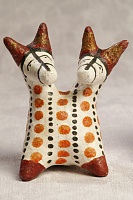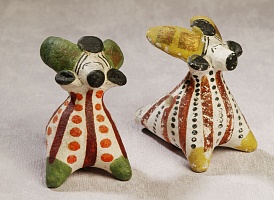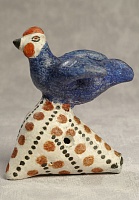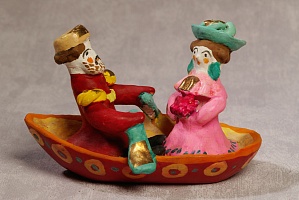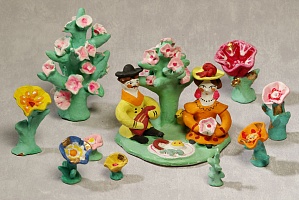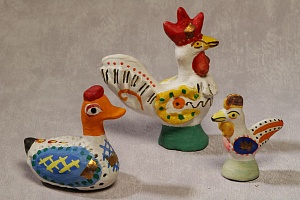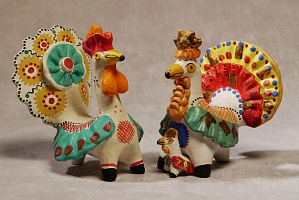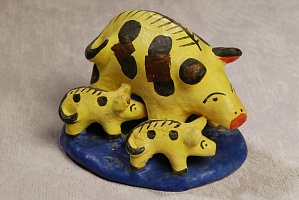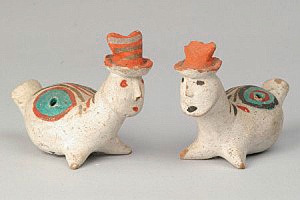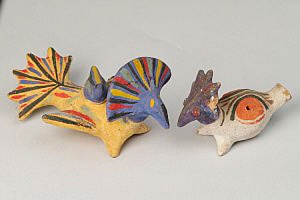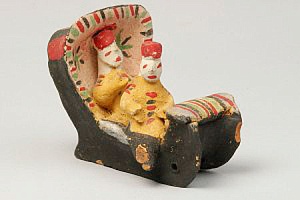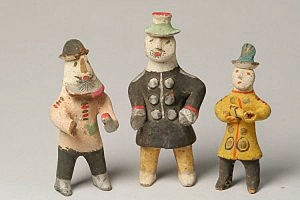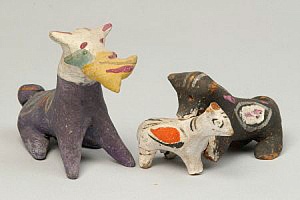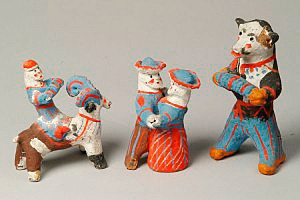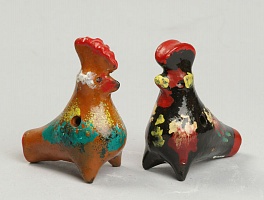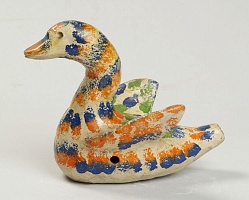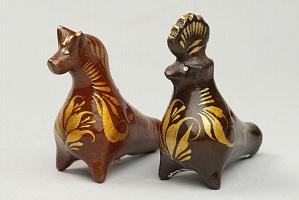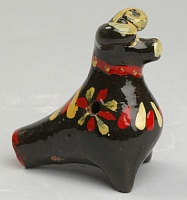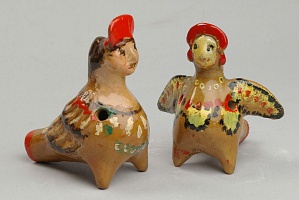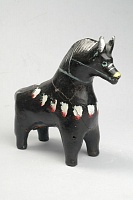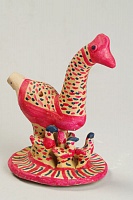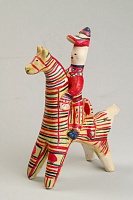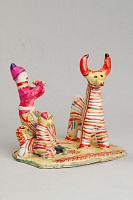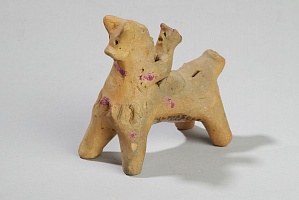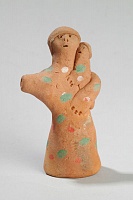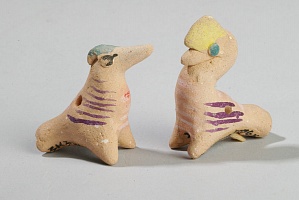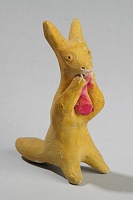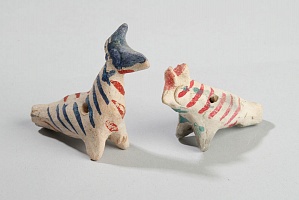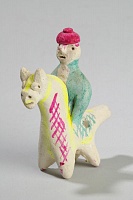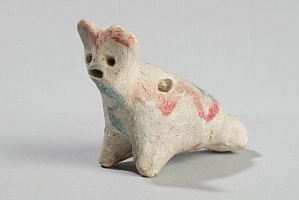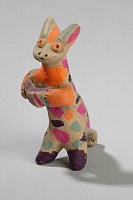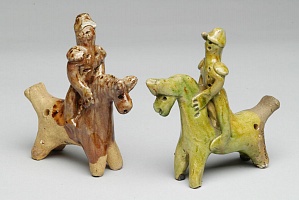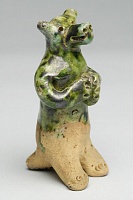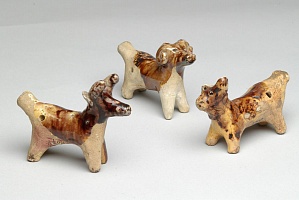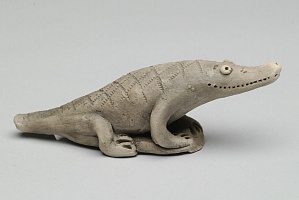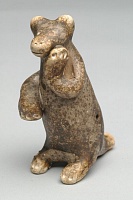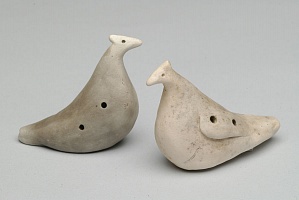Clay Toys 19th - 20th cc.
Dymkovo Toys
The Museum-Reserve possesses a large collection of folk clay toys from the famous centers: Dymkovo, Kargopol, Gorodetsky, Zhbannikov, Filimonovo, Orel and Skopin. It can be regarded as one of the best collections in Russia. Pottery has existed on earth for centuries and millennia. And so might clay toys, that are a peculiar and somewhat mysterious sphere of folk art. Since the hoary antiquity they have preserved small plastic forms with their own range of colors and their specific painted and molded decoration. Clay toys present is a particular aspect in folk art: their function was not always significant. Many molded and painted figurines were not for game, they were interior decorations, like porcelain statuettes. Yet, traditionally they are called toys.
Clay toys from Dymkovo settlement near Vyatka (Kirov) are perhaps most famous. They are widely represented in many museums. For many people, the very concept of Russian clay toys is associated with Dymkovo figurines and whistles. Female artisans’ art is rooted in remote ages. The 19th century samples, that can be referred to the earlier period of Dymkovo toys, are very rare. They are nothing like bright, multi-colored toys of contemporary Dymkovo.
The old and contemporary Dymkovo characters are numerous and diverse. They are ladies, officers and horsemen; young ladies and gentlemen walking and boating; nurses; water carriers, milkmaids and riders; real and fabulous animals and birds. Usually they are free-standing figures. There are few genre compositions on the platform, dating back to the earlier period. The most numerous group includes toys-whistles.
As Mezrina’s toys, the works of Koss-Denishina impress with their plastic perfection, they are expressive even without painting. Her female figures are very shapely. They combine conventional Dymkovo molding with correct anatomy and sculptural expressiveness, like the toys of the 19th century. E.I. Koss-Denshina’s toys are easily recognizable. She worked out her own style. Her toys are marked with the artist’s precise eye and her ability to emphasize the features typical of this or that character.
Kargopol Toys
The Kargopol toys constitute the most numerous group in the Museum collection. The basic group (362 items) contains the works, made by Ivan and Ekaterina Druzhinin, their namesakes Egor and Uliana Druzhinin and their daughter Lubov, Anastasia Barkhatova, M. Voronova, N. Ya. Zamyatina, A.V. Babkina in the village of Grinyevo (Kargopol district, Arkhangelsk region) in autumn and winter of 1936 – 1937. The toys were named after the place of their origin. The Kargopol toys reached the same level, as the toys from Vyatka and other centers. They are not just toys for children. Wise adults can also “play” with them
In the 1930s, the restoration of the traditional folk art centers involved the Kargopol districtб as well. Good opportunities for the individual development were provided. The toys of Ivan and Ekaterina Druzhinin are among the best samples both in Kargopol, and in Russia. The statuesque figurines are covered with ornament of delicate color treatment. Like in other toy centers, the images are birds, horses, deer, bears, goats, sheep, dogs and some variants of female characters.
In the 1970s, Uliana Babkina was the most famous Kargopol toy-maker. Her toys were laconically painted. The head and hands of human figures were painted white, the clothes were large color spots with ornaments. The animal heads were whitewashed, the eyes and sometimes eyebrows were painted with the brush strokes; horns, tails and legs were outlined in a colored contour. The backs were decorated with a fishbone ornament, the sides – with large red circles and sidelong crosses. She used glue tempera and gouache, occasionally water color or in what was sent and brought by her numerous guests and customers.
Gorodets toys
The Gorodets district in the Nizhny Novgorod region is a famous wood-carving center, but the manufacture of clay whistles - "reed pipes" is a little-known folk craft. The clay toys were traditionally made in the village of Zhbannikovo. In the early 1930s, a young artisan Larion Trifonovich Potatuyev (1912-1941) developed a new trend. At that time his name was inseparable from the Gorodets clay whistles, like the names of Ivan V. Druzhinin and Ulyana Babkina from the Kargopol clay toys. Making whistles, he sometimes turned to more complex forms, creating roosters, or combining a conic whistle with a human figure.
In the 1950s - 1980s, a young talented craftswoman Praskovia Stepanovna Timofeyevna (b. 1925) from the village of Ryzhukhino made whistles: cockerels, lambs, cows and other animals. She seldom turned to large forms. Her small, diverse and shapely toys favorably differed from other local figurines.
In the 1980s, a native craftsman Venedikt Stepanovich Sirotkin (1928-1985) successfully worked in Zhbannikovo. He created more complicated forms of whistles: birds with relief molded wings and fan-shaped tails, horses, lambs, etc .The techniques of whistle decoration were preserved. The molded toys were put in close rows on the boards and dried in the shade for several days. Then they were fired and glazed in bright red, orange, yellow, green and blue colors. The whole toy was covered with one color. Then aluminum paint was applied for the animal horns, ears, hooves, tail ends and the bird combs. Several spots of contrasting glaze made the toys look like “Khokhloma”.
Filimonovo toys
The clay toys from Filimonovo village ( Odoyevsky district, Tula region) are represented by the samples of the 1950s – 1970s. They are real works of folk art perfectly reflecting traditional worldview and aesthetic ideals of Russian peasants. Tall ladies with thin waists and disproportionately small heads in wide bell-shaped skirts, riders on funny horses with giraffe necks, fantastic striped animals were very attractive.
The unusually bright toys decorated with pink, yellow, blue and green geometric patterns, differed greatly from the well-known Dymkovo ladies, water carriers and riders. They became a discovery for many connoisseurs, as well as, for the majority of specialists in Russian art. The millennial tradition could be traced in their silhouettes, shapes, ornaments. They are similar to the 10th – 11th century clay figures, found during the archeological excavations in Kiev. But, perhaps, most of all, the Filimonovo toys with their modeling and painting resembled ancient Greek terracotta sculptures..
Few old toys of the mid- 19th - early 1930s, preserved just in several museums, prove that they can be estimated as the best Felimonovo works. The contemporary specimens, richly represented in the museums and private collections, are mainly referred to the late 1950s - 1970s.
Almost all Filimonovo toys, regardless of the images, are whistles. The bird – the favorite image in all toy centers – was frequently and variously repeated in Filimonovo. There were many variants of "ducks", "roosters" and "chickens". The original Filimonovo style was preserved by the eldest native craftswomen: A. G. Karpova (1911 – 1992) and members of the USSR Union of Artists: A. F. Maslennikova (1910 – 1970) and A. I. Derbeneva (1909 – 1990). Now the Filimonovo tradition is maintained by E. A. Orlova (the granddaughter of A. I. Derbeneva and A. F. Maslennikova).
Orel and Kursk toys
Neither Kursk clay toys made in the 1930s, nor Orel toys of the 1960s prompt by their appearance. Despite some new details, they are archetypal symbols of peasant art sticking to the ancient traditions.
The earliest reference appeared in “The Orel Province Bulletin” of 1866: “Pottery in …Pleshkovo of the Livensky district”; “ The Orel Province Index” of 1880 stated: “The craft is ancient”. The Pleshkovo images were not varied. They were popular peasant characters - ladies, horsemen, cows, roosters.The Voronezh and Kursk figurines, made in the 1930s, were similar in their peasant aspect to the whistles, made in the 1970s by the sisters Uliana Ivanovna Kovkina and Olga Deriglazova and also Valentina Venediktovna Kovkina from the village of Kozhlya in the Kursk region.
Skopin Toys
The town of Skopin, situated on the left bank of the Verda reiver in the Southern part of the Ryazan region, is fairly famous for the original ceramic vessels. Known since the second half of the 19th century, they became the main branch among the contemporary Skopin handicrafts. The Skopin toys are mainly expressive figures of animals: chiefly bears and “soldiers” on horseback. Less frequent are compositions on the small platforms, obviously designed as statuettes for the chests of drawers rather than children toys
Skopin toys collecting in Sergiev Posad began in 1937, when the Moscow Museum of Folk Handicrafts was housed in the Lavra buildings. Dozens of clay toys, including Skopin specimens, were transferred from the State Tretyakov gallery and the State Russian Museum.
The main characters, including animals and birds, bear, horsemen and ladies, are typical of folk toys in all centers. But in Skopin, as elsewhere, local techniques of assembling, molding and decoration were formed. The Skopin toys are original, they can not be confused.
In October, 2003, the Museum expedition acquired several works made on the models of old toys by the contemporary craftswomen I.A. Yakushina and T.A. Kiseleva. The smoky-grey birds are exceptionally good. The craftswomen also try to decorate toys with boiling in different blends (flour, milk, kvass, and even beer) to gain the variety of color (from light beige to red-brown).









